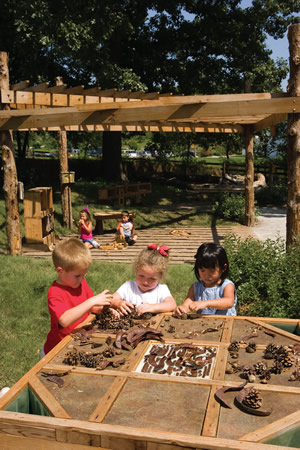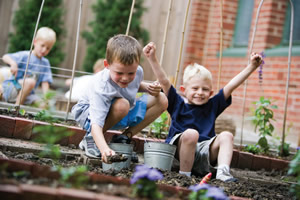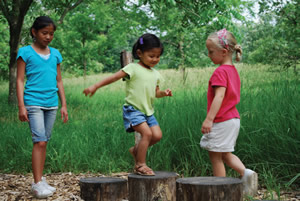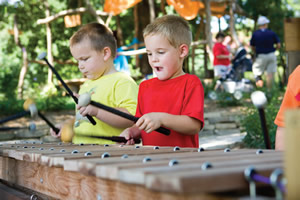Facilities (Learning Spaces)
Whole-Child Learning
- By Dex Lane
- January 1st, 2015

PHOTO COURTESY OF THE ARBOR DAY FOUNDATION
Outdoor classrooms are becoming increasingly popular at schools, either in addition to traditional playgrounds, or instead of them. Museums, libraries and nature centers are adopting outdoor classrooms as means of enhancing their educational missions and boosting attendance. Childcare programs adopt them to reinforce their commitment to quality care. Many women’s shelters have them as learning spaces, and as refuges for children and families under stress.
Because no two programs are alike, the same is true of their outdoor classrooms. Each is tailored to the program it complements. Landscape architects and outdoor learning specialists are presented with unique challenges and opportunities in designing these important and engaging natural spaces.
For the landscape architect, sifting through the many approaches to outdoor classroom design is the first step in the planning process. This article is based on the design considerations and guiding principles developed at Nature Explore, a collaborative project of the Dimensions Educational Research Foundation and the Arbor Day Foundation. The Nature Explore Design team, in its hundreds of Outdoor classroom designs, has drawn from continually evolving research on children’s learning in outdoor environments, as well as from client experiences.
The outdoor classroom is not simply a beautifully designed natural space for children’s play and learning. To be effective, it must be a space in which children can develop intellectual, socio-emotional, and physical skills in a nature-rich environment. Although its primary user is the child, it must also speak to educators, parents, and other caretakers who engage with children in the space.
Guiding principles that differentiate an “as-is” natural space from an effective outdoor classroom underlie major design decisions. Primary principles include dividing the space into clearly delineated activity areas, and ensuring that these areas together constitute a comprehensive mix of different activities. Each activity area supports both learning, and creative expression of the children’s thoughts and discoveries. These areas help children to plan and focus their explorations.
Areas would include nature art, music and movement (usually with a stage), messy materials (a collection of branches, sticks, tree cookies, etc., that is to be left messy), a gathering area, and a garden (or a pathway through plantings). Each area should be designated by signage or some other clearly visible clue to its function. Also, each area should be filled with a variety of natural materials for study and imaginative play. Materials or structures that are not themselves natural, such as a performance stage made of composite decking, rakes and colored scarves should be chosen for their durability and enhancement of the child’s connection to nature.

PHOTO © NATURE EXPLORE
Learning With Nature. Designers, teachers, educators and parents want to see children excited by their own discoveries in the natural world. They see “whole-child learning” involving simultaneous intellectual, socio-emotional and body-awareness development. And everyone reaps the benefits of children who develop respect for the environment.
Although not an activity area, an entry feature is highly recommended. This could be an archway made of wood or plantings, a gate with natural decorations, signage or some other feature that indicates entry into the natural area. The past few generations of children have been largely disconnected from nature in their daily lives. The outdoor classroom, for most, is truly a reconnection with nature. The entry feature, like a decorative entrance to a museum, is a signal to all that they are transitioning into a very special place.
The designated areas allow children to plan and develop activities with appropriate resources. Areas that contain similar activities, such as the Nature Art and Building areas, can be contiguous. The Music and Movement area, featuring instruments such as an all-season marimba, complement the stage. Areas promoting more quiet work, such as nature art, should be set away from large open areas, which promote vigorous activities.
Nature-rich design elements are used to delineate the soft boundaries between activity areas. Elements such as slight grade changes, plantings, spaced rocks, stumps or tree trunks, and paths signal passage from one area to the next.

PHOTO © NATURE EXPLORE
Existing features such as trees and rocks are left in place whenever possible. Yet plantings of other trees, flowers, grasses, and bushes add beauty and life to the space. Placement of natural features and plantings is important to both the aesthetics and effectiveness of the outdoor classroom. Even small areas with knee-high bushes or grasses, with a path between them, give children the experience of moving through nature. The child sitting between plantings, alone or with friends, feels a sense of privacy, despite being safely in the teacher’s view. Plantings should be of native species, with a variety of sizes and colors and blooming periods. Plantings throughout the outdoor classroom may be irrigated.
The garden area may consist of raised planter boxes, each box with a different type of plant. Examples include butterfly gardens, herb and vegetable gardens, scent gardens and even medicine gardens. Raised planter boxes allow children to garden and explore plants at a comfortable level. Worm and compost bins are great assets to this area. Caring for the garden area is a major activity, and hand watering from a nearby spigot or other source adds more learning.
“Loose parts” are essential features of any outdoor classroom. These are natural objects, such as sticks, branches, seashells and pinecones that may be studied, used in artwork or constructions, used as props in plays and more. Because they are not manufactured toys, the child’s imagination gives them form and function. Play with loose parts creates challenges and opportunities, exercises of intellect, and creativity rarely found on traditional playgrounds. Loose parts are usually easily available and can be collected and donated by teachers and parents. Storage may be necessary for some small loose parts, while larger materials, such as branches, may be left in the messy materials area.
Items such as building blocks, art supplies, and gardening supplies require secure storage if they are not to be brought inside each evening. Depending on the size of the space, along with the storage needs of different areas, multiple secured storage areas might be necessary. For natural items such as pinecones and seashells, open shelf storage are appropriate in every area they are used.
Along with storage, maintenance is an important and ongoing consideration. Natural materials used in an outdoor classroom break down as part of their natural lifecycle. Plants grow and die. Leaves fall. All these processes are learning experiences, and all involve maintenance and teachable moments. Incorporating observation and study of nature’s changes into the children’s experience is a primary activity in any outdoor classroom. Planning for this learning, and for the ongoing maintenance associated with nature’s changes, should begin early in the design stage.
Surfacing is determined by usage and climate. Pathways may be made from mulch, crushed stone, pavers, or flagstone. Flagstone is also a great surface for the Nature Art area, as it can function as a temporary “canvas” when water is applied with a brush. Some outdoor classrooms have sturdy grass wherever possible, and some are largely surfaced with wood chips.

PHOTO © NATURE EXPLORE
While a child’s learning through exploratory free-play is enriched in outdoor classrooms, so too is curriculum-based learning. When the outdoor classroom is fully utilized, what can be taught indoors can be taught outdoors. Schools such as the St. Augustine Indian Mission School in Winnebago, Neb. hold regular academic lessons outdoors that had been conducted indoors. St. Augustine teachers say that their children simply focus more easily and learn better outdoors than indoors.
For clients that will use the outdoor classroom for regular group meetings (such as schools and nature centers), sufficient and comfortable seating in the Gathering area is important. Seating should serve both adults and children. Moveable benches allow various seating configurations, while stumps, logs and rocks may also be used.
Designers of outdoor classrooms always have partners who can contribute fresh and important ideas: the children and adults who will use the space. For many adults, especially those who had little exposure to nature during their own childhood, being able to understand the power of naturebased learning involves a cognitive shift. Adults who have received information regarding the outdoor classroom’s role and function will often contribute invaluable design ideas. For the most part, young children who currently experience nature in their lives already “get it,” and have great ideas.
It’s not hard to understand why many who work in outdoor classroom design consider themselves part of a movement. They see the rapid transformations in behaviors of children transitioning from traditional playgrounds to outdoor classrooms. Gender-segregated play in playgrounds, where might often makes right, will give way to boys and girls engaged in projects together in an outdoor classroom.
Designers, teachers, educators and parents see children excited by their own discoveries in the natural world. They see “whole-child learning” involving simultaneous intellectual, socio-emotional and body-awareness development. And everyone reaps the benefits of children who develop respect for the environment.
Designing outdoor classrooms is professionally challenging and richly rewarding. To some, it’s a calling. Says Jim Wike, design director with the Nature Explore program, “I have the best job in the world.”
This article originally appeared in the January 2015 issue of School Planning & Management.